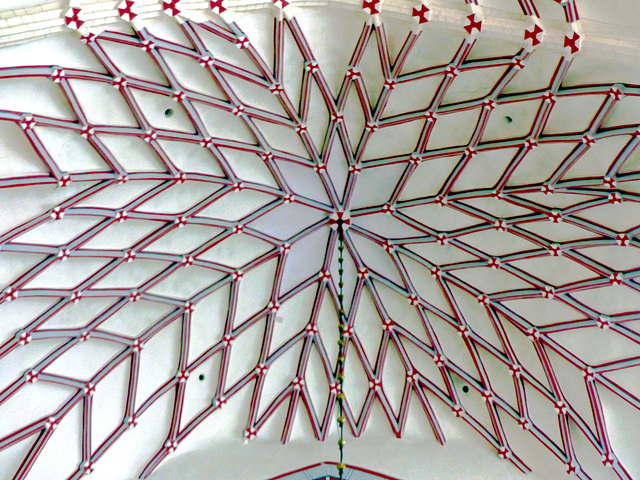Location
Lat, Lng:
Lat, Lng:
You can copy the above to your favourite mapping app.
Address: unknown
Lat, Lng:
You can copy the above to your favourite mapping app.
Address: unknown
See also...
Keywords
Authorizations, license
-
Visible by: Everyone -
All rights reserved
-
52 visits
Riga - Svētā Jāņa baznīca


Riga is the capital of Latvia. With a population of more than 600.000 about a third of all Latvians live here. A settlement of the Finno-Ugric Livs existed on the bank of the Düna. At the end of the 12th century, merchants from Gotland came to trade here.
Albert von Buxthoeven, a fierce missionary, was the first bishop in Riga from 1201 to 1229. Riga developed as the hub of Russian trade and the starting point of the German colonization of the Baltic.
The merchants who settled here after the subjugation of the surrounding peoples rapidly gained influence. In 1225, they were able to elect the city bailiff themselves, when the City Council existed already.
After the Reformation, the power of the archbishops came to an end. After the outbreak of the Livonian War in 1558 the city favoured the status of a free imperial city of the Holy Roman Empire. It was only when the imperial support failed to materialize that the renewed advance of Russian armies led the city to pay homage to Poland's King Stephen Báthory in 1581, who in return confirmed the city's traditional freedoms and privileges.
The 40-year Polish-Lithuanian rule, under which the citizens of Riga successfully resisted anti-Reformation efforts ended with the conquest of the city by Gustav II Adolf of Sweden in 1621. The Swedish crown treated Riga by its rank as the second-largest city in the kingdom and had it lavishly fortified. During the Russo-Swedish War (1656-1658), Riga withstood the Russian siege and maintained its position as one of the most important cities in Sweden until the beginning of the 18th century. During this period the city enjoyed extensive self-government.
St. John's Church belonged as a chapel to the neighbouring Dominican monastery from 1234. The first documented mention of the church dates back to 1297. At the end of the 15th century, the church was destroyed during battles between the Teutonic Order and the City of Riga.
In the period around 1500, the church was rebuilt in its present form. In 1520 it received its net vaults.
In 1523, in the course of the Reformation, the Dominicans were deprived of the church and the church was used as an armoury. In 1582, the church was handed over to the Latvian Lutheran parish.
The single-nave church interior is spanned by a star vault. There are four bays, twelve meters wide and up to 19 meters high, with the late Gothic network.
Translate into English
Albert von Buxthoeven, a fierce missionary, was the first bishop in Riga from 1201 to 1229. Riga developed as the hub of Russian trade and the starting point of the German colonization of the Baltic.
The merchants who settled here after the subjugation of the surrounding peoples rapidly gained influence. In 1225, they were able to elect the city bailiff themselves, when the City Council existed already.
After the Reformation, the power of the archbishops came to an end. After the outbreak of the Livonian War in 1558 the city favoured the status of a free imperial city of the Holy Roman Empire. It was only when the imperial support failed to materialize that the renewed advance of Russian armies led the city to pay homage to Poland's King Stephen Báthory in 1581, who in return confirmed the city's traditional freedoms and privileges.
The 40-year Polish-Lithuanian rule, under which the citizens of Riga successfully resisted anti-Reformation efforts ended with the conquest of the city by Gustav II Adolf of Sweden in 1621. The Swedish crown treated Riga by its rank as the second-largest city in the kingdom and had it lavishly fortified. During the Russo-Swedish War (1656-1658), Riga withstood the Russian siege and maintained its position as one of the most important cities in Sweden until the beginning of the 18th century. During this period the city enjoyed extensive self-government.
St. John's Church belonged as a chapel to the neighbouring Dominican monastery from 1234. The first documented mention of the church dates back to 1297. At the end of the 15th century, the church was destroyed during battles between the Teutonic Order and the City of Riga.
In the period around 1500, the church was rebuilt in its present form. In 1520 it received its net vaults.
In 1523, in the course of the Reformation, the Dominicans were deprived of the church and the church was used as an armoury. In 1582, the church was handed over to the Latvian Lutheran parish.
The single-nave church interior is spanned by a star vault. There are four bays, twelve meters wide and up to 19 meters high, with the late Gothic network.
Ulrich John has particularly liked this photo
- Keyboard shortcuts:
Jump to top
RSS feed- Latest comments - Subscribe to the comment feeds of this photo
- ipernity © 2007-2024
- Help & Contact
|
Club news
|
About ipernity
|
History |
ipernity Club & Prices |
Guide of good conduct
Donate | Group guidelines | Privacy policy | Terms of use | Statutes | In memoria -
Facebook
Twitter

Sign-in to write a comment.